Technical Report
Moran Lake Water Quality Study
& Conceptual Restoration Plan
A series of restoration projects and programmatic activities have been presented in the previous section. In this section a general review of planning and implementation options is outlined for restoration, public education, and programmatic activities. Preliminary cost information is also presented for the projects. A preliminary constraint analysis that reviews the potential benefits and constraints associated with each project is also presented to rank and prioritize the projects.
6.1. Planning and Implementation
Several tasks are required to plan and implement the various restoration and programmatic activities outlined in this plan. In order to carry out many of the restoration projects, additional technical studies, engineering analysis and design, and environmental review and permitting will be required. Public resources of both staff time and funding would be required to implement several of the programmatic activities.
6.1.1.Funding
Because County funding sources are limited, other sources should be reviewed for partial or full funding of projects listed below. Current possibilities include the California Coastal Conservancy (grants and loans for coastal access and wetland enhancement), US Environmental Protection Agency and California State Water Resources Control Board (water quality grant funding) and the Monterey Bay National Marine Sanctuary.
6.1.2. Restoration Project Implementation
Planning and implementing a restoration project normally involves several phases of work, including:
- Planning and technical analysis;
- Environmental review and permitting;
- Engineering and preparation of construction documents; and
- Project implementation or construction.
Planning and
Technical Analysis.
At the initial phase of a project, additional data gathering, such as a topographic survey and completion of technical studies, including hydrologic, biotic and archaeological studies may be necessary to evaluate the feasibility and/or design and permit a project.
Environmental Review and Permitting.
Once a project is considered feasible and supporting technical studies have been completed, the project will undergo an environmental review process to comply with the California Environmental Quality Act (CEQA). At this stage of project an environmental site assessment study may be conducted to determine the potential for adverse environmental effects that may require mitigation or alteration of the project design. Relevant CEQA documents would be prepared and subject to a public review process. Once the environmental review process is conducted, local, state and/or federal permits may need to be obtained in order to execute a project.
Preparation of Construction Documents.
Once a project has been approved and permitted, construction documents are prepared. These documents typically include engineering design plans and specifications, an engineering cost estimate for the project, and construction bid and contract documents.
Project Implementation.
Project implementation or construction typically involves pre-project, construction and post construction activities. Pre-project activities for many restoration projects occurring in stream and wetland settings can involve pre-project biotic monitoring, installing temporary dewatering or stream diversion systems, construction surveying and establishing a construction staging area. Once the pre-project activities are completed the project is constructed. After completion post-construction activities are commonly required to clean up the construction zones, and monitor and maintain the project, usually for a three to five year period.
Section 6.2 presents preliminary cost estimates to plan and construct seven proposed restoration and education projects identified in Section 5.
6.1.3. Public Education and Programmatic Activities
In Section 5 public education and programmatic activities have been identified. These include:
·
Interpretative trail and signing around Moran Lake;
·
Public education and outreach; and
·
Storm water management activities.
Interpretative Trail and Signing.
As previously discussed the existing trails within the Moran Lake County Park are well used and present an opportunity to develop an educational and interpretive signs. The unique lagoon ecosystem and monarch habitat provide educational themes for community members, visitors, and students. To develop and implement an interpretative trail and signing project the following activities are suggested:
1. Establish a voluntary oversight committee to raise funds and oversee the development and installation of interpretative displays;
2. Begin to acquire funds to plan, develop, and install interpretative displays;
3. Retain an individual or graphics design firm to prepare a plan for the interpretative trail and signing and to prepare the signs.
4. Install (or improve) trails and install signs.
Public Education and Outreach.
Several public education and outreach activities have been mentioned in Section 5. In summary the main activities discussed include:
·
Formation of a watershed group through the California Coordinated
Resource Management and Planning (CRMP) process;
·
Organized community activities and informational forums focused on
the water quality issues, natural history, restoration of streams and coastal
lagoons, and storm water management strategies;
·
Storm water and water quality workshops for small commercial and
industrial businesses in the Live Oak area;
·
Preparation and distribution of informational brochures to
community members; and
·
Volunteer days for stream cleanup and exotic plant species’
removal.
Through the watershed planning activities of the Santa Cruz County Resource Conservation District the community may be able to obtain technical assistance to start a watershed group. Once the watershed group is formed than the group might seek additional funds to hire a part-time coordinator to help organize watershed group activities, and to conduct fundraising activities for broader outreach efforts.
Storm Water Management Activities.
Adopting new storm water control measures are an important step towards reducing the amount of pollutants from urbanized areas in the watershed to protect the lagoon and Monterey Bay. Various storm water management and treatment practices are available to reduce pollutants. In Section 5 three major areas of storm water management are outlined:
·
Innovative site design;
·
Use of storm water control and treatment best management practices
(BMPs); and
·
Establishing performance standards for site design and storm water
control and treatment BMPs.
These activities would be implemented on a county-wide basis under the auspices of the County of Santa Cruz’s Storm Water Management Program currently underway. The County Program should consider the recommendations contained in this plan as their activities relate to the Moran Lake watershed area. Additional implementation efforts beyond the County’s program are not recommended at this time.
6.2. Project Cost Analysis
Preliminary costs have been prepared for several restoration and public education projects outlined in the plan. Eight separate projects were analyzed:
1. Replacing of the box culvert on East Cliff Drive with an arched and bottomless culvert;
2. Construction of a wetland in the upper arm of Moran Lake;
3. Reshaping and stabilizing the eroded bank on the east side of Moran Lake;
4. Removal of invasive and non-native plants and revegetation with native plantings;
5. Modifying the 38th Avenue Detention Basin to include a storm water wetland on the bottom of the existing basin;
6. Restoring portions of Moran Creek and riparian corridor;
7. Installing interpretative signs around the lagoon.
Costs for forming a watershed group, and conducting public education and outreach activities have not been included, although they are expected to be nominal.
6.2.1. Replacement of the East Cliff Drive Box Culvert with a Arched, Bottomless Culvert
Although limited benefits are expected to be achieved, an arched and bottomless culvert could replace the existing box culvert to restore the lagoon inlet to a more natural configuration. Using an arched culvert to provide a clear span across the lagoon inlet would be a least cost method, as compared to a clear span or trestle style bridge. Preliminary cost estimates for this project are presented in Table 6.1 below.
Table 6.1.
Preliminary Cost Estimate for Arched Bottomless Culvert
For East Cliff
Drive Crossing
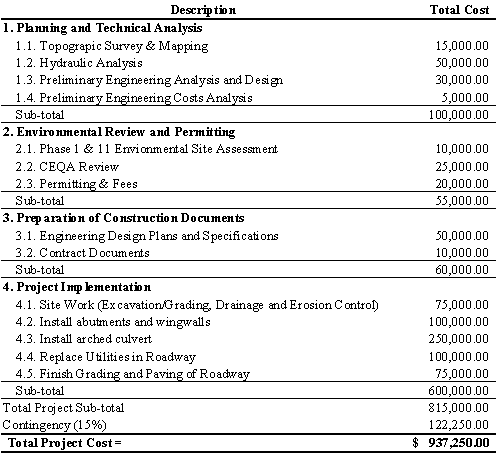
6.2.2. Upper Lagoon Wetland
A wetland in the upper lagoon would improve lower lagoon water quality and create wildlife foraging and nesting habitat. Construction of a wetland would also restore more natural hydrologic conditions within the lagoon by recreating a wetland area where it probably existed historically. Table 6.2 presents a preliminary cost estimate to construct a wetland in the upper arm of the lagoon. The preliminary costs include trails and two small foot bridges to provide for recreational access around the wetland.
Table 6.2. Preliminary Cost Estimate for Wetland in Upper Lagoon
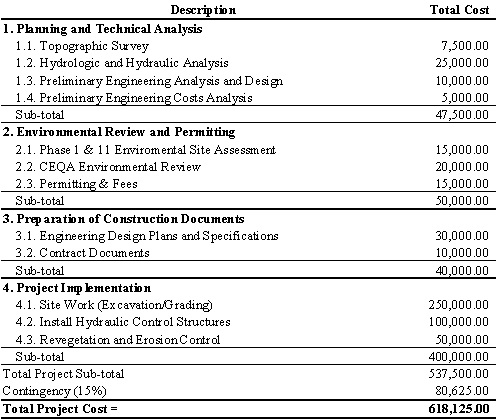
6.2.3. Reshape and Stabilize Lagoon Bank
Undertaking a bank stabilization project on the east side of the lagoon is important to protect the pedestrian/bicycle path and to reduce the likelihood of further erosion. A bank stabilization project that employs a biotechnical solution, incorporating a combination of vegetation and structural elements is desirable to restore the bank to a more natural configuration and to restore habitat value to the disturbed area. Access in this area is an important link to the surrounding neighborhood to the east. Table 6.3 presents a preliminary cost estimate for the project.
Table 6.3.
Preliminary Cost Estimate for Bank Stabilization Project
on east side of
Lagoon
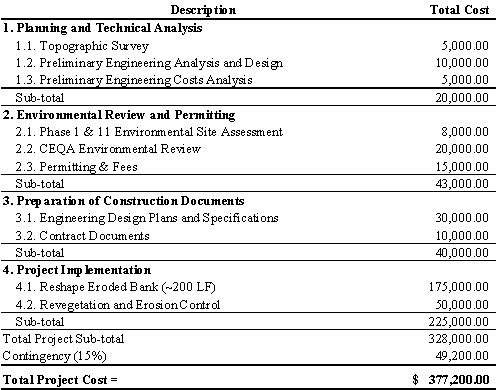
6.2.4. Modify 38th Avenue Detention Basin with a Low-Flow Wetland
The existing storm water detention basin located at 38th could be modified to function as a storm water treatment wetland during low flow events. The existing detention basin would need to be reconfigured to divert runoff through the wetland during low flow periods allowing it to capture nutrient, bacteria and heavy metals contained in urban runoff. During high flow events the wetland would be temporarily inundated, also providing some pollutant retention. The wetland could also be designed to provide some wildlife habitat value. Table 6.4 presents preliminary cost estimates to retrofit the detention basin.
Table 6.4. Preliminary Cost Estimate to Modify 38th Avenue Detention Basinwith a Low-Flow Wetland
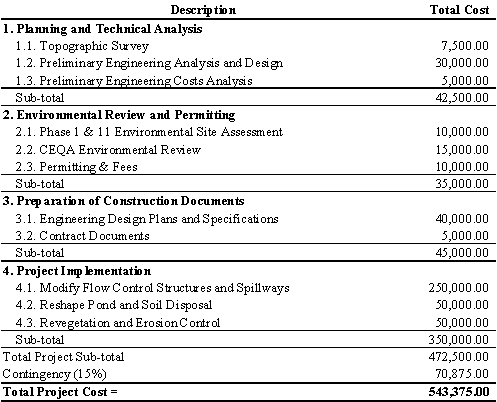
6.2.5. Restore Moran Creek Corridor
Development in the Moran Lake watershed has significantly reduced the Moran Creek riparian corridor and floodplain. To enhance the condition of Moran Creek any opportunity to restore undeveloped or redeveloped lands to increase the stream corridor and daylight the stream would be a significant benefit to the watershed. In areas where a narrow above-ground channel exists, widening of the stream corridor to provide for a functional riparian corridor buffer should be considered. For planning purposes, preliminary cost estimates have been prepared to restore approximately 1,000 lineal feet of stream channel in the watershed. These costs, as presented in Table 6.5, do not include any property acquisition costs.
Table 6.5. Preliminary Cost Estimate for 1000 feet of Channel Restoration
6.2.6. Removal of Non-Native Invasive Plants and Revegetation with Natives
Table 6.6. Cost Estimate for Non-Native Plant Removal and Revegetation
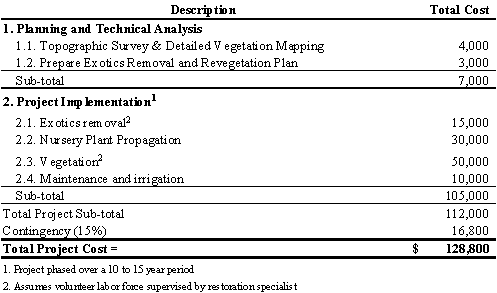
6.2.7. Interpretative Signs
Table 6.7. Costs for Interpretative Signs and Trails
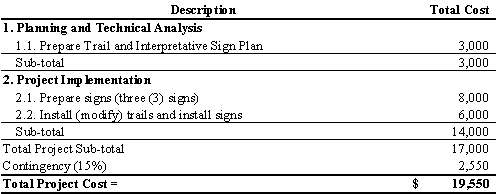
6.3. Constraint Analysis
A preliminary constraint analysis has been prepared to identify and rank potential benefits and constraints that would either be achieved or may impede the successful completion any of the projects. The results of the analysis are summarized in Table 6.8. Since the overall goal is to improve water quality and habitat conditions in Moran Lake, the potential benefits include basic water quality and habitat enhancement. Several potential constraints have been identified including:
- Permit Complexity - The project could require numerous permits and a complex permit approval process
- Technical Feasibility – Evaluates whether the project directly improves water quality or habitat conditions
- Property Acquisition – The project may require purchasing private property or securing easements. Costs of this have not been considered
- Environmental Remediation – The project may require environmental remediation of toxic materials, including environmental testing and remedial corrective action (eg. soil excavation and disposal)
- Sensitive Species Mitigation - The project may have sensitive species present and would require mitigation of potential impacts or loss of habitat
- Cost – Program costs are ranked based on cost estimates above
- Maintenance and Monitoring – Project may require on-going maintenance or periodic monitoring to achieve stated goals
Table 6.8. Benefits and Constraints Analysis
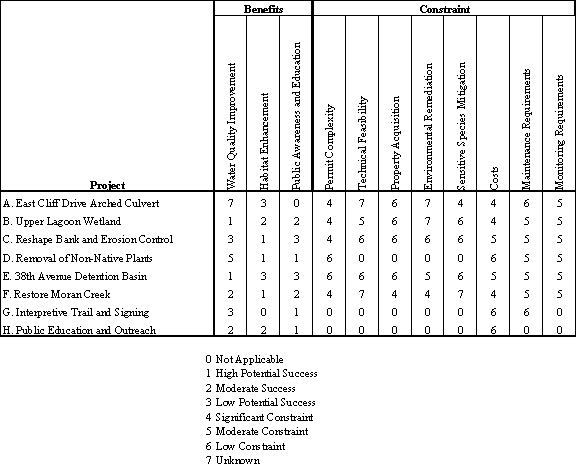
To summarize: 1) The cost-efficient projects, d. non-native plant removal, g. trails/ signing and h. public education will have moderate to major benefits without significant constraints. 2) The moderate and higher cost projects—e. modification of 38th Avenue detention basin, c. erosion control on Moran Lake east bankslope, and b.the upper lagoon wetland also appear to have moderate to significant benefits without major constraints. The County should prioritize these projects and pursue funding from outside sources as needed. 3) Project f., restoration of selected reaches of Moran Creek above the lagoon could be very costly if land acquisition is necessary, but may be less expensive and provide water quality and habitat benefits if restoration occurred as part of the design for new development projects. Coordination with the Planning Department would be necessary to implement this recommendation. 4) Project a., replacement of the East Cliff box culvert with a bridge or arched culvert is also an expensive project that would require further hydrologic and environmental analyses to determine if benefits outweigh constraints.















